(p. A13) If economics is a science, it is more like biology than physics. Biologists try to understand the relationships in a complex system. That’s hard enough. But they can’t tell you what will happen with any precision to the population of a particular species of frog if rainfall goes up this year in a particular rain forest. They might not even be able to count the number of frogs right now with any exactness.
We have the same problems in economics. The economy is a complex system, our data are imperfect and our models inevitably fail to account for all the interactions.
The bottom line is that we should expect less of economists. Economics is a powerful tool, a lens for organizing one’s thinking about the complexity of the world around us. That should be enough. We should be honest about what we know, what we don’t know and what we may never know. Admitting that publicly is the first step toward respectability.
Month: June 2010
Mob Museum Financed from Local, State and Federal Tax Dollars
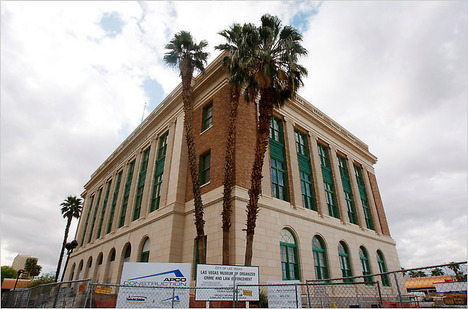 “The $42 million museum has been financed through a series of state, federal and local grants. It is set to open next March.” Source of caption and photo: online version of the NYT article quoted and cited below.
“The $42 million museum has been financed through a series of state, federal and local grants. It is set to open next March.” Source of caption and photo: online version of the NYT article quoted and cited below.
(p. 4) The idea for the Las Vegas Museum of Organized Crime and Law Enforcement was seeded when the city bought the 1933 federal courthouse and post office from the federal government for $1 in 2002, with the strict understanding that the building — one of the oldest in Southern Nevada — be used for cultural purposes.
For much of the middle of the last century, organized crime ruled the Strip, developing and managing an array of casinos, skimming their way to success. Federal prosecutors put an end to their reign in the 1980s. The city determined its historical relationship to organized crime — and the role the courthouse played in it — made the site a perfect fit.
. . .
The $42 million project has been financed through a series of state, federal and local grants, and the work has progressed a bit glacially as money has trickled in.
The project, once listed as one that could stimulate this city’s embattled economy, was attacked by Senator Mitch McConnell, the Republican leader, when city officials suggested that it might qualify for federal stimulus money.
For the full story, see:
JENNIFER STEINHAUER. “‘2 Mob Museums in Las Vegas, Ready to Go to the Mattresses.” The New York Times, First Section (Sun., April 25, 2010): 1 & 4.
(Note: ellipsis added.)
(Note: the online version of the article is dated April 24, 2010 and has the title “Vegas Mob Museums, Set to Go to the Mattresses.”)
Scientific Calculators Creatively Destroyed Slide Rules
(p. 120) I’d been a slide rule whiz in high school, so when I saw the calculator, it was just amazing. A slide rule was kind of like a ruler– you had to look at it precisely to read the values. The most accurate number you could get was only three digits long, however, and even that result was always questionable. With a calculator, you could punch in precisely the digits you wanted. You didn’t have to line up a slider. You could type in your numbers exactly, hit a button, and get an answer immediately. You could get that number all the way out to ten digits. For example, the real answer might be 3.158723623. An answer like that was much more precise than anything engineers had ever gotten before.
Well, the HP 35 was the first scientific calculator, and It was the first in history that you could actually hold in your hand. It could calculate sines and cosines and tangents, all the trigonometric and exponential/logarithmic functions engineers use to calculate and to do their jobs. This was 1973, and back then cal-(p. 121)culators–especially handheld calculators–were a very, very big deal.
. . .
There was no doubt in my mind that calculators were going to put slide rules out of business. (In fact, two years later you couldn’t even buy a slide rule. It was extinct.) And now all of a sudden I’d gotten a job helping to design the next generation of these scientific calculators. It was like getting to be a part of history.
Source:
Wozniak, Steve, and Gina Smith. iWoz: Computer Geek to Cult Icon: How I Invented the Personal Computer, Co-Founded Apple, and Had Fun Doing It. New York: W. W. Norton & Co., 2006.
(Note: ellipsis added.)
Global Warming Would Benefit British Sparkling Wine Growers
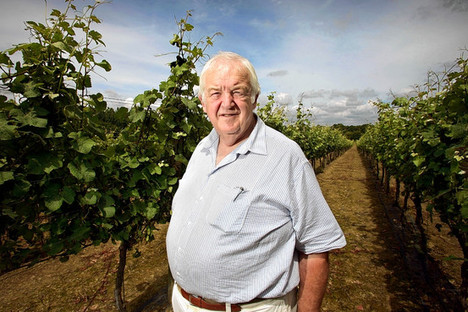 “Mike Roberts, at Ridgeview in 2007, says making wine is easier now.” Source of caption and photo: online version of the WSJ article quoted and cited below.
“Mike Roberts, at Ridgeview in 2007, says making wine is easier now.” Source of caption and photo: online version of the WSJ article quoted and cited below.
(p. A1) DITCHLING, England–The English invented sparkling wine in the 17th century, but failed to profit from it because their cold, dank summers yielded crummy grapes. Three decades later, a French monk named Dom Pérignon adapted the idea and devised a winning tipple, Champagne.
The Brits are starting to claw back some ground. In January, a little-known bubbly from the U.K’s Nyetimber Estate was crowned “world’s best sparkling wine” at a prestigious taste-off in Italy, defeating a dozen Champagnes, including Roederer, Bollinger and Pommery. Last year, when Britain hosted the G-20 meeting, another effervescent Nyetimber was served to President Barack Obama, Germany’s Angela Merkel and President Nicolas Sarkozy of France.
English bubbly is on the rise partly due to better winemaking techniques. But some vintners say they’re being helped by another, unexpected factor: a warming climate.
Official data indicate that the past 10 years were the warmest on record globally. In England, this led to plumper and riper grapes most seasons, especially for sparkling wines. The number of vineyards in the U.K. jumped to 416 in 2008 from 363 in 2000, according the trade group English Wine Producers
“Just 20 years ago, it was really difficult to make good wine in cooler climate areas,” says Gregory Jones, who studies the effect of climate change on the (p. A18) global wine industry at Southern Oregon University. “Now it’s not such a challenge.”
With the help of warmer summers, “some of the risk of making sparkling wine here is gone,” says Mike Roberts, founder and chief winemaker of the Ridgeview estate here, 45 miles south of London. “We have everything going for us to out-Champagne Champagne.”
Last year, the fifth-hottest on record, Ridgeview’s grapes ripened two weeks earlier than usual, allowing for the harvest to be brought in before the onset of wet October weather. Mr. Roberts and other English winemakers say 2009 was one of the best growing seasons they’ve seen.
For the full story, see:
GAUTAM NAIK. “‘Warmer Climate Gives Cheer to Makers of British Bubbly; Thanks to Milder Summers, England Takes Some Air Out of France’s Famous Tipple.” The Wall Street Journal (Tues., May 11, 2010): A1 & A18.

Ridgeview Estate’s wine “to out-Champagne Champagne.”
Source of photo: http://www.goodfoodpages.co.uk/images/listings/1580/large/ridgeview.jpg Source of quote: Mike Roberts above.
Barney Frank Calls European Agriculture Policy “Ridiculous”
(p. A13) Mr. Frank said the Jeffersonian notion that farming was a superior form of life has led to subsidies and protectionism in the U.S. Similar problems exist in the European Union. Saying EU agriculture policy is “ridiculous,” Frank claimed European farmers should be bought out.
The idea that the “noble yeoman” must be protected at all costs leads to protectionism, Frank said.
For the full story, see:
Neal Lipschutz. “Davos Dispatch: Frank vs. Thomas Jefferson on Farming and Protectionism.” The Wall Street Journal (Thurs., Jan 28, 2010): A13.
A version of the brief story appeared online as:
Neal Lipschutz. “Davos Live; Frank Takes On Jefferson Over Farming.” Posted Jan 28, 2010. http://blogs.wsj.com/davos/2010/01/27/frank-takes-on-jefferson-over-farming/?KEYWORDS=Thomas+Jefferson+Protectionism
Companies Make Big Bets to Get Us What We Need
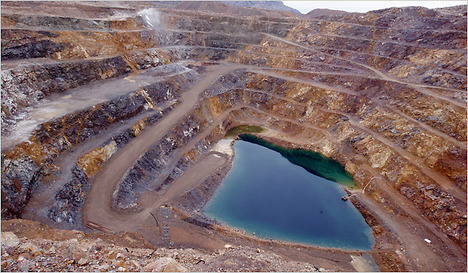 “The Molycorp Minerals rare earth mine in Mountain Pass, Calif.” Source of caption and photo: online version of the NYT article quoted and cited below.
“The Molycorp Minerals rare earth mine in Mountain Pass, Calif.” Source of caption and photo: online version of the NYT article quoted and cited below.
If the government does not interfere with the price system, then the prospect of higher prices will provide private companies and entrepreneurs the incentive to take risks to provide us with what we need. In the article quoted below, the example is rare earth minerals that are used in high technology products.
(p. B1) On a high plateau where burros and jackrabbits wander an hour’s drive southwest of Las Vegas, a 400-foot-deep chasm hewn from volcanic rock sits at the center of an international policy debate.
The chasm, in Mountain Pass, Calif., used to be the world’s main mine for rare earth elements — minerals crucial to military hardware and the latest wind turbines and hybrid gasoline-electric cars. Molycorp Minerals, which owns the mine, announced on Monday that it had registered with the Securities and Exchange Commission for an initial public offering to help raise the nearly $500 million needed to reopen and expand the mine.
Molycorp is making a big bet that its mine — once the world leader in production of rare earth elements, but now a rusting relic — can be made competitive again. Global demand is surging for the minerals. And customers, particularly the American military, are seeking alternatives to China, which now mines 97 percent of the world’s rare earth elements.
As part of reopening the mine, Molycorp plans to increase its capacity to mine and refine neodymium for rare earth magnets, which are extremely lightweight and are used in many high-tech applications. It will also resume bulk production of lower-value rare earth elements like cerium, used in industrial processes like polishing glass and water filtration.
For the full story, see:
KEITH BRADSHER. “A Mine Owner’s Risky Bet on Rare Minerals.” The New York Times (Thur., April 22, 2010): B1 & B4.
(Note: italics in original; ellipses added.)
(Note: the online version of the review is dated April 21, 2010 and has the title “Challenging China in Rare Earth Mining.”)
In the Age of Vacuum Tubes, 6th Grader’s Dad Showed Him How Transistors Work
Wozniak went on to invent the personal computer.
This example would probably fit with some of what Malcolm Gladwell claims in his bestseller Outliers.
(p. 15) I have to point out here that at no time did my dad make a big deal about my progress in electronics. He taught me stuff, sure, but he always acted as if it was just normal for me. By the sixth grade, I was really advanced in math and science, everyone knew it, and I’d been tested for IQ and they told us it was 200-plus. But my dad never acted like this was something he should push me along with. He pulled out a blackboard from time to time, a tiny little blackboard we had in our house on Edmonton Avenue, and when I asked, he would answer anything and make diagrams for it. I remember how he showed me what happened if you put a plus voltage into a transistor and got a minus voltage out the other end of the transistor. There must have been an inverter, a type of logic gate. And he even physically taught me how to make an AND gate and an OR gate out of parts he got–parts called diodes and resistors. And he showed me how they needed a transistor in between to amplify the signal and connect the output of one gate to the input of the other.
(p. 16) To this very moment, that is the way every single digital device on the planet works at its most basic level.
He took the time–a lot of time–to show me those few little things. They were little things to him, even though Fairchild and Texas Instruments had just developed the transistor only a decade earlier.
It’s amazing, really, to think that my dad taught me about transistors back when almost no one saw anything but vacuum tubes. So he was at the top of the state of the art, probably because his secret job put him in touch with such advanced technology. So I ended up being at the state of the art, too.
The way my dad taught me, though, was not to rote-memorize how parts are connected to form a gate, but to learn where the electrons flowed to make the gate do its job. To truly internalize and understand what is going on, not just read stuff off some blueprint or out of some book.
Those lessons he taught me still drive my intelligence and my methods for all the computer designs I do today.
Source:
Wozniak, Steve, and Gina Smith. iWoz: Computer Geek to Cult Icon: How I Invented the Personal Computer, Co-Founded Apple, and Had Fun Doing It. New York: W. W. Norton & Co., 2006.
The reference to the Gladwell book is:
Gladwell, Malcolm. Outliers: The Story of Success. New York, NY: Little, Brown, and Co., 2008.
Finding the Neanderthal in Us
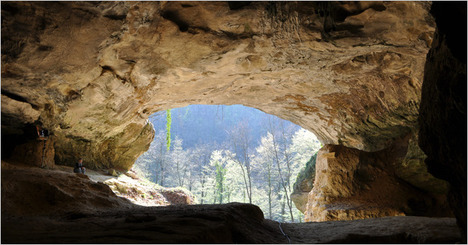 “The Vindija cave in Croatia where three small Neanderthal bones were found.” Source of caption and photo: online version of the NYT article cited below.
“The Vindija cave in Croatia where three small Neanderthal bones were found.” Source of caption and photo: online version of the NYT article cited below.
(p. A3) The burly Ice Age hunters known as Neanderthals, a long-extinct species, survive today in the genes of almost everyone outside Africa, according to an international research team who offer the first molecular evidence that early humans mated and produced children in liaisons with Neanderthals.
In a significant advance, the researchers mapped most of the Neanderthal genome–the first time that the heredity of such an ancient human species has been reliably reconstructed. The researchers, able for the first time to compare the relatively complete genetic coding of modern and prehistoric human species, found the Neanderthal legacy accounts for up to 4% of the human genome among people in much of the world today.
By comparing the Neanderthal genetic information to the modern human genome, the scientists were able to home in on hints of subtle differences between the ancient and modern DNA affecting skin, stature, fertility and brain power that may have given Homo sapiens an edge over their predecessors.
“It is tantalizing to think that the Neanderthal is not totally extinct,” said geneticist Svante Pääbo at the Max Planck Institute for Evolutionary Anthropology in Leipzig, Germany, who pioneered the $3.8 million research project. “A bit of them lives on in us today.”
. . .
For their analysis, Dr. Pääbo and his colleagues extracted DNA mostly from the fossil remains of three Neanderthal women who lived and died in Croatia between 38,000 and 45,000 years ago. From thimblefuls of powdered bone, the researchers pieced together about three billion base pairs of DNA, covering about two-thirds of the Neanderthal genome. The researchers checked those samples against fragments of genetic code extracted from three other Neanderthal specimens.
“It is a tour de force to get a genome’s worth,” said genetic database expert Ewan Birney at the European Bioinformatics Institute in Cambridge, England.
In research published Thursday in Science, the researchers compared the Neanderthal DNA to the genomes drawn from five people from around the world: a San tribesman from South Africa; a Yoruba from West Africa; a Han Chinese; a West European; and a Pacific islander from Papua, New Guinea. They also checked it against the recently published genome of bio-entrepreneur Craig Venter. Traces of Neanderthal heredity turned up in all but the two African representatives.
For the full story, see:
ROBERT LEE HOTZ. “Most People Carry Neanderthal Genes; Team Finds up to 4% of Human Genome Comes From Extinct Species, the First Evidence It Mated With Homo Sapiens.” The Wall Street Journal (Fri., MAY 7, 2010): A3.
(Note: ellipsis added.)
(Note: the online version of the review is dated MAY 6, 2010.)
A related article, the online version of which is the source for the caption and photo above, is:
NICHOLAS WADE. “Analysis of Neanderthal Genome Points to Interbreeding with Modern Humans.” The New York Times (Fri., May 7, 2010): A9.
(Note: the online version of the review is dated May 6, 2010 and has the title “Signs of Neanderthals Mating With Humans.”)
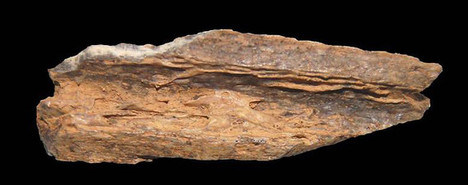 “A close-up of the bone Vindija 33.16 from Vindija cave, Croatia.” Source of caption and photo: online version of the WSJ article quoted and cited above.
“A close-up of the bone Vindija 33.16 from Vindija cave, Croatia.” Source of caption and photo: online version of the WSJ article quoted and cited above.
Fannie Mae and Freddie Mac Are Still a “Burgeoning Money Pit” for Taxpayers
(p. 1) If you blinked, you might have missed the ugly first-quarter report . . . from Freddie Mac, the mortgage finance giant that, along with its sister Fannie Mae, soldiers on as one of the financial world’s biggest wards of the state.
Freddie — already propped up with $52 billion in taxpayer funds used to rescue the company from its own mistakes — recorded a loss of $6.7 billion and said it would require an additional $10.6 billion from taxpayers to shore up its financial position.
The news caused nary a ripple in the placid Washington scene. Perhaps that’s because many lawmakers, especially those who once assured us that Fannie and Freddie would never cost taxpayers a dime, hope that their constituents don’t notice the burgeoning money pit these mortgage monsters represent. Some $130 billion in federal money had already been larded on both companies before Freddie’s latest request.
But taxpayers should examine Freddie’s first-quarter numbers not only because the losses are our responsibility. Since they also include details on Freddie’s delinquent mortgages, the company’s sales of foreclosed properties and losses on those sales, the results provide a telling snapshot of the current state of the housing market.
That picture isn’t pretty. Serious delinquencies in Freddie’s single-family conventional loan portfolio — those more than 90 days late — came in at 4.13 percent, up from 2.41 percent for the period a year earlier. Delinquencies in the company’s Alt-A book, one step up from subprime loans, totaled 12.84 percent, while delinquencies on interest-only mortgages were 18.5 percent. Delinquencies on its small portfolio of op-(p. 2)tion-adjustable rate loans totaled 19.8 percent.
The company’s inventory of foreclosed properties rose from 29,145 units at the end of March 2009 to almost 54,000 units this year. Perhaps most troubling, Freddie’s nonperforming assets almost doubled, rising to $115 billion from $62 billion.
For the full commentary, see:
Gretchen Morgenson. “Fair Game; Ignoring the Elephant in the Bailout.” The New York Times, SundayBusiness (Sun., May 9, 2010): 1-2.
(Note: ellipsis added.)
(Note: the online version of the article was dated May 7, 2010.)
Mr. Africa Carries a Gun to Keep the Press Free
 “Anchors read the latest news from around the world this month in the studio at Radio Mogadishu, which opened in 1951.” Source of caption and photo: online version of the NYT article quoted and cited below.
“Anchors read the latest news from around the world this month in the studio at Radio Mogadishu, which opened in 1951.” Source of caption and photo: online version of the NYT article quoted and cited below.
(p. A6) This is a typical day at Radio Mogadishu, the one and only relatively free radio station in south central Somalia where journalists can broadcast what they like — without worrying about being beheaded. The station’s 90-foot antennas, which rise above the rubble of the neighborhood, have literally become a beacon of freedom for reporters, editors, technicians and disc jockeys all across Somalia who have been chased away from their jobs by radical Islamist insurgents.
. . .
Somalia has become one of the most dangerous places in the world to practice journalism, with more than 20 journalists assassinated in the past four years. “We miss them,” Mr. Africa said about his fallen colleagues.
He cracked an embarrassed smile when asked about his name. “It’s because I’m dark, really dark,” he said.
Mr. Africa used to work at one of the city’s other radio stations (the city has more than 10) but decided to move on after fighters with the Shabab dropped by and threatened to kill the reporters if they did not broadcast pro-Shabab news. Mr. Africa called the Shabab meddlers “secret editors” and now he carries a gun.
“I tried to get the other journalists to buy pistols,” Mr. Africa remembered. “But nobody listened to me.”
Another reporter, Musa Osman, said that his real home was only about a mile away.
“But I haven’t seen my kids for months,” he said.
He drew his finger across his throat and laughed a sharp, bitter laugh when asked what would happen if he went home.
The digs here are hardly plush. Most of the journalists sleep on thin foam mattresses in bald concrete rooms. The station itself is a crumbling, bullet-scarred reflection of this entire nation, which has been essentially governmentless for nearly two decades.
. . .
They air the speeches of insurgent leaders, they say, and stories about government soldiers robbing citizens.
“If the government does something bad,” Mr. Africa said. “We report it.”
For the full story, see:
JEFFREY GETTLEMAN. “Mogadishu Journal; A Guiding Voice Amid the Ruins of a Capital City.” The New York Times (Tues., March 30, 2010): A6.
(Note: ellipses added.)
(Note: the online version of the review is dated March 29, 2010.)
Wozniak’s Dad Taught Him the Power of Technology
(p. 12) . . . my dad taught me . . . a lot about electronics. Boy, do I owe a lot to him for this. He first started telling me things and explaining things about electronics when I was really, really young–before I was even four years old. This is before he had that top secret job at Lockheed, when he worked at Electronic Data Systems in the Los Angeles area. One of my first memories is his taking me to his workplace on a weekend and showing me a few electronic parts, putting them on a table with me so I got to play with them and look at them. I can still picture him standing there working on some kind of equipment. I don’t know if he was soldering or what, but I do remember him hooking something up to something else that looked like a little TV set. I now know it was an oscilloscope. And he told me he was trying to get something done, trying to get the picture on the screen with a line (it was a waveform) stable-looking so he could show his boss that his design worked.
And I remember sitting there and being so little, and thinking: Wow, what a great, great world he’s living in. I mean, that’s all I (p. 13) thought: Wow. For people who know how to do this stuff–how to take these little parts and make them work together to do something–well, these people must be the smartest people hi the world. That was really what went through my head, way back then.
Now, I was, of course, too young at that point to decide that I wanted to be an engineer. That came a few years later. I hadn’t even been exposed to science fiction or books about inventors yet, but just then, at that moment, I could see right before my eyes that whatever my dad was doing, whatever it was, it was important and good.
Source:
Wozniak, Steve, and Gina Smith. iWoz: Computer Geek to Cult Icon: How I Invented the Personal Computer, Co-Founded Apple, and Had Fun Doing It. New York: W. W. Norton & Co., 2006.
(Note: ellipses added.)

